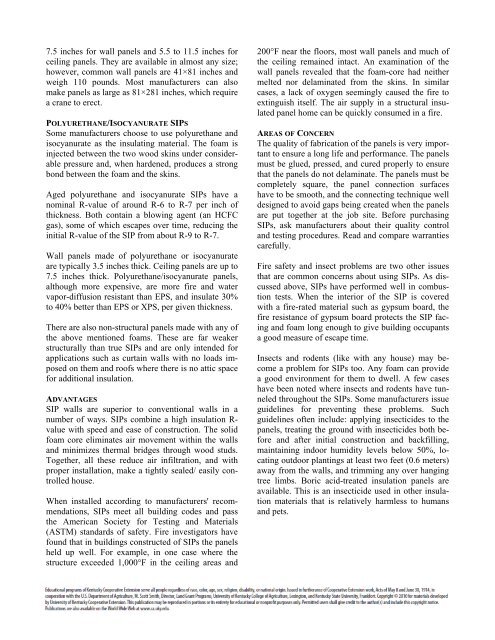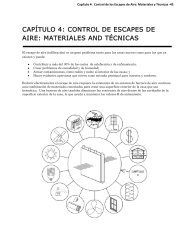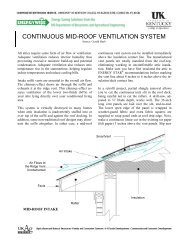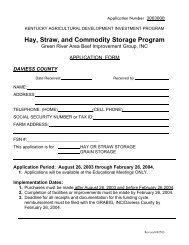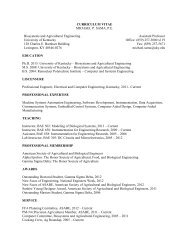STRUCTURAL INSULATED PANELS
STRUCTURAL INSULATED PANELS
STRUCTURAL INSULATED PANELS
You also want an ePaper? Increase the reach of your titles
YUMPU automatically turns print PDFs into web optimized ePapers that Google loves.
7.5 inches for wall panels and 5.5 to 11.5 inches for<br />
ceiling panels. They are available in almost any size;<br />
however, common wall panels are 41×81 inches and<br />
weigh 110 pounds. Most manufacturers can also<br />
make panels as large as 81×281 inches, which require<br />
a crane to erect.<br />
POLYURETHANE/ISOCYANURATE SIPS<br />
Some manufacturers choose to use polyurethane and<br />
isocyanurate as the insulating material. The foam is<br />
injected between the two wood skins under considerable<br />
pressure and, when hardened, produces a strong<br />
bond between the foam and the skins.<br />
Aged polyurethane and isocyanurate SIPs have a<br />
nominal R-value of around R-6 to R-7 per inch of<br />
thickness. Both contain a blowing agent (an HCFC<br />
gas), some of which escapes over time, reducing the<br />
initial R-value of the SIP from about R-9 to R-7.<br />
Wall panels made of polyurethane or isocyanurate<br />
are typically 3.5 inches thick. Ceiling panels are up to<br />
7.5 inches thick. Polyurethane/isocyanurate panels,<br />
although more expensive, are more fire and water<br />
vapor-diffusion resistant than EPS, and insulate 30%<br />
to 40% better than EPS or XPS, per given thickness.<br />
There are also non-structural panels made with any of<br />
the above mentioned foams. These are far weaker<br />
structurally than true SIPs and are only intended for<br />
applications such as curtain walls with no loads imposed<br />
on them and roofs where there is no attic space<br />
for additional insulation.<br />
ADVANTAGES<br />
SIP walls are superior to conventional walls in a<br />
number of ways. SIPs combine a high insulation R-<br />
value with speed and ease of construction. The solid<br />
foam core eliminates air movement within the walls<br />
and minimizes thermal bridges through wood studs.<br />
Together, all these reduce air infiltration, and with<br />
proper installation, make a tightly sealed/ easily controlled<br />
house.<br />
When installed according to manufacturers' recommendations,<br />
SIPs meet all building codes and pass<br />
the American Society for Testing and Materials<br />
(ASTM) standards of safety. Fire investigators have<br />
found that in buildings constructed of SIPs the panels<br />
held up well. For example, in one case where the<br />
structure exceeded 1,000°F in the ceiling areas and<br />
200°F near the floors, most wall panels and much of<br />
the ceiling remained intact. An examination of the<br />
wall panels revealed that the foam-core had neither<br />
melted nor delaminated from the skins. In similar<br />
cases, a lack of oxygen seemingly caused the fire to<br />
extinguish itself. The air supply in a structural insulated<br />
panel home can be quickly consumed in a fire.<br />
AREAS OF CONCERN<br />
The quality of fabrication of the panels is very important<br />
to ensure a long life and performance. The panels<br />
must be glued, pressed, and cured properly to ensure<br />
that the panels do not delaminate. The panels must be<br />
completely square, the panel connection surfaces<br />
have to be smooth, and the connecting technique well<br />
designed to avoid gaps being created when the panels<br />
are put together at the job site. Before purchasing<br />
SIPs, ask manufacturers about their quality control<br />
and testing procedures. Read and compare warranties<br />
carefully.<br />
Fire safety and insect problems are two other issues<br />
that are common concerns about using SIPs. As discussed<br />
above, SIPs have performed well in combustion<br />
tests. When the interior of the SIP is covered<br />
with a fire-rated material such as gypsum board, the<br />
fire resistance of gypsum board protects the SIP facing<br />
and foam long enough to give building occupants<br />
a good measure of escape time.<br />
Insects and rodents (like with any house) may become<br />
a problem for SIPs too. Any foam can provide<br />
a good environment for them to dwell. A few cases<br />
have been noted where insects and rodents have tunneled<br />
throughout the SIPs. Some manufacturers issue<br />
guidelines for preventing these problems. Such<br />
guidelines often include: applying insecticides to the<br />
panels, treating the ground with insecticides both before<br />
and after initial construction and backfilling,<br />
maintaining indoor humidity levels below 50%, locating<br />
outdoor plantings at least two feet (0.6 meters)<br />
away from the walls, and trimming any over hanging<br />
tree limbs. Boric acid-treated insulation panels are<br />
available. This is an insecticide used in other insulation<br />
materials that is relatively harmless to humans<br />
and pets.


